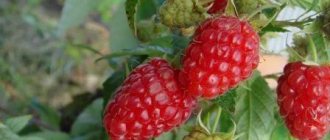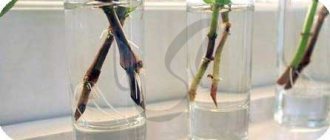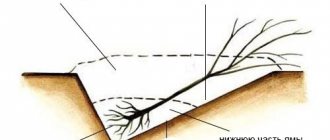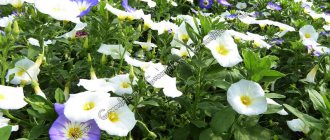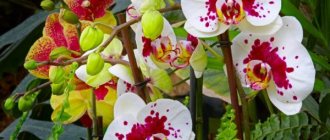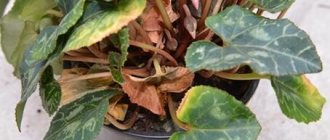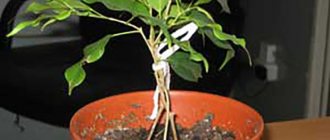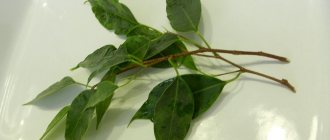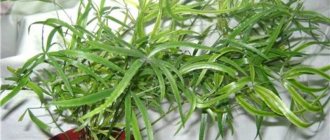Tabernemontana or ervatamia is an evergreen flowering plant from the Kutrov family. In the wild, it can be found in the tropical zones of Southeast Asia, Africa, and America. India and Ceylon are considered to be the birthplace of the plant. This complex name was given to the flower by the botanist Charles Plumier at the beginning of the 18th century in honor of the German scientist Jacob Theodor Tabernemontanus. He was the creator of the work “New Herbalist”, in which he described the properties of famous plants, including Ervatamia.
Tabernemontana in temperate latitudes is grown only indoors. It has become popular not only among collectors of exotic flora, but also among novice flower growers. The plant not only decorates the interior all year round with evergreen foliage and abundant flowering, but is also characterized by its ease of care.
History of names
Charles Plumier
This complex name was assigned to the flower by the French botanist Charles Plumier in 1713 in honor of the German scientist Jacob Dietrich Müller of Bergzabern (1522 - 1590). Müller did not like his last name, so he translated the name of his hometown into Latin, took it as a pseudonym, and began to engage in scientific activities under the pseudonym Jacob Theodore Tabernemontanus. He was a famous doctor and botanist, a specialist in balneology and was the creator of the “New Herbalist”, in which he tried to bring together all the knowledge about the medicinal properties of known plants. It was he who was the first to describe the medicinal properties of Ervatamia (the future Tabernemontana) in his Herbal Book. The first editions of the “Herbal” were in 1588 and 1591, but the most famous was the revised edition of the “New Herbal” in 1613, edited by the Swiss scientist K. Baugin.
India, Ceylon and Singapore are considered the birthplace of the flower. There it grows everywhere, and has a very nice local name - “Flower of Love”. In addition, the plant can be found in humid, warm areas of Africa, and in the coastal regions of South and Central America. There it is grown as an outdoor shrub. In cooler climates, Tabernemontana is grown as a houseplant, or rather, some of its species, which we will talk about later. If you translate the name of the flower into Russian, it will literally mean “Mountain Abode” or “Mountain Tavern”.
During flowering, Tabernemontana becomes similar to a blooming Oleander. Hence the flower got another name - “East Indian Oleander”. By the way, Oleander and Tabernemontana are close relatives, both belong to the Kutrovye family.
In appearance, the flower is also very similar to Gardenia, their leaves are especially similar. In Russia, Tabernemontana is often confused with this plant. “Butterfly Gardenia” is how the locals of Singapore and India lovingly call Tabernemontana. But these plants have many differences.
Plant characteristics
Tabernemontana belongs to the Kutrov family. It got its name in honor of the German scientist who first described the plant. His name was Jacob Tabernemontanus. He was the "father" of German botany. During his life he described a large number of plants. Tabernemontana is found in subtropical and tropical zones:
- Africa;
- South-East Asia;
- America.
It grows in height up to one and a half meters. The stem is strong and woody. The leaves are leathery with a glossy sheen and distinct veins. With pointed ends and oblong shape. The maximum leaf length is 25 cm. Inflorescences can include up to 20 buds. Flowers reaching 6 cm in diameter can be:
- white;
- creamy;
- terry;
- simple.
Under favorable circumstances, an ovary forms after the flowers. Over time, it grows into a fruit with seeds. The bush blooms almost all year round. The peak occurs in spring and summer. Botanists identify almost 100 species of this plant, but only some varieties are popular among gardeners.
Tabernemontana divaricata has a spherical crown with large leaves and white inflorescences. The aroma of flowers intensifies in the dark. The fruits are dark green.
Description of the flower
As we already wrote above, this decorative flowering evergreen shrub at home can grow from half a meter to one and a half meters in height. Its lifespan with proper care can reach seven years or more. Over time, its stems become lignified, become strong and covered with very light-colored bark.
On numerous stems there are oppositely located leaves, which have an oblong shape with pointed and bent down tips. They are glossy, leathery, and rich green in color. Tabernemontana's leaves are surprisingly dense and beautiful! Less common are varieties with leaves speckled with yellow and even variegated ones. Depending on the type of plant, the length of one leaf ranges from 7 to 12 cm, and the width is 3 to 5 cm. Thick short petioles complete the description of the leaves.
The flowers of the plant are most often snow-white, sometimes cream. Tabernemontana flowers are double or semi-double, with a diameter of 4 to 8 cm, collected in several pieces in corymbose inflorescences. The flowering of Tabernemontana is very reminiscent of the white dresses of brides. The bush seems to be completely covered with snow-white lace. Flower petals appear ruffled and waxy. Up to fifteen flowers are formed in an inflorescence, but no more than three bloom at the same time. Inflorescences do not stop appearing on the tops of shoots all year round; there are up to 20 of them on a plant. Add to this charm the wonderful aroma that these blooming bouquets emit all day, and, intensifying in the evening, fragrant throughout the night - and you will be an eternal admirer of this plant!
We repeat - Tabernemontana blooms all year round! Don't worry that she will use up all her strength, become exhausted and die prematurely. If you follow the simple rules of its maintenance, Tabernemontana will delight you with its appearance and smell for many years to come. Peak flowering occurs in spring and summer. At the end of flowering, the plant first forms ovaries, and over time, fruits, in the form of large dark green pods with seeds. The fruits, when ripe, have juicy orange pulp. Some Ervatamia species have edible fruits.
Beneficial features
The beneficial properties of Tabernemontana have been known to people for a long time. In oriental medicine, the tops and roots of the plant are used to prepare antipyretic, expectorant and astringent medicines. Also used as a remedy for parasites. An extract from the leaves of the plant is added to medicine for eye diseases. In addition, the fruits of some Tabernemontana species are considered edible there, and drinks are prepared from them.
Seven secrets of success:
| 1. Growing temperature : in spring and summer it is quite warm at a temperature of 18 to 24 ° C, in winter a cool dormant period is desirable at a temperature of 5 - 10 ° C. |
| 2. Lighting : light shading from direct rays of the sun in spring and summer, maximum light in autumn and winter. |
| 3. Watering and air humidity : during the growth period, watering is abundant and regular with drying of the top layer of soil between them; in the winter months, the frequency of watering is greatly reduced. Air humidity increases when the air temperature rises above 24° C. |
| 4. Pruning : easily tolerates formative pruning, which is carried out after flowering; remove old and diseased branches in a timely manner. |
| 5. Soil : nutritious, loose, well-drained, with a slightly acidic pH. |
| 6. Feeding : in spring and summer, when tabernemontana is growing, we feed it monthly; in winter we do not feed it. If kept warm, the frequency of fertilizing in the winter months can be reduced to once a month. |
| 7. Reproduction : by stem cuttings or sowing seeds. |
Botanical name : Tabernaemontana.
Tabernemontana flower - family . Kutrovye.
Origin . Tropical regions of Asia.
Description . The genus "tabernemontana" or Indian carnation consists of approximately 120 plant species that are perennial evergreen shrubs with a rounded crown. The stems branch abundantly, young shoots are green, but with age they become lignified and covered with light brown bark. When damaged, the stems release a milky sap. The leaves are large, glossy, dark green, oblong-oval, up to 15 cm long, located opposite. The flowers are single, white with 5 rounded petals, up to 5 cm in diameter. Modern varieties have corrugated edges of the petals and fragrant flowers. In its appearance, tabernemontana resembles jasmine.
Height . This shrub grows slowly and reaches a height of 1 - 2 m, but it is easy to regulate by pruning.
Varieties and types
More than a hundred species of Tabernemontana are found in the natural environment; in culture there are much fewer of them. We will introduce you to some of the most popular ones below.
Devarikata
Tabernaemontana divaricata (lat. Tabernaemontana divaricata) is the most common type of this indoor flower. This tree, with a densely branched spherical crown, has large leaves of a rich green color. The transverse veins are clearly visible on the reverse side of the sheet. The branches grow horizontally. Large corymbose inflorescences at the ends of the shoots are strewn with snow-white flowers. The buds are formed from five petals with corrugated edges. The aroma of white double inflorescences is persistent, sweet, similar to the aroma of jasmine. This fragrance is especially intensified at night. The fruits ripen in the form of oblong pods of dark green, sometimes lightly speckled, color with juicy orange pulp.
Elegant
Tabernaemontana elegans is a well-branched tree considered ideal for home growing for its amazing beauty and easy-going nature. It is not as tall and fragrant as the previous type. Its flowers are five-petalled, not double, and have a weak aroma. But this indoor plant is the most resilient and will easily tolerate direct sunlight or light frosts.
Crowned
Tabernaemontana crowned (lat. Tabernaemontana coronaria) is a medium-sized, richly branched bush with glossy embossed leaves of a bright green color, reaching a length of 12 cm. Flowers are formed at the ends of the shoots. An inflorescence can produce up to 15 buds at once, which gradually open into medium-sized semi-double flowers with a pronounced aroma.
Holst
Holst's Tabernaemontana (lat. Tabernaemontana holstii) is a rare species. A distinctive feature is its originally curved petals of white flowers, which are shaped very much like a propeller. The shape of the leaves is oval-elongated, their color is bright green, rich.
This may be interesting: Diseases and pests of gloxinia - how to deal with them
Tabernemontana Sanango (lat. Tabernaemontana sananho) has dense green leaves reaching a length of 30 cm. The petals are long, narrow, intricately wrapped. Its fruits are considered edible.
In addition to beautifully flowering species, variegated varieties, represented by many variegated forms, are cultivated in home floriculture.
Caring for Tabernemontana at home
Surprisingly, this tropical guest, having settled in the same apartment with you, will not require special attention and care. To successfully grow Tabernemontana, three growth components will be sufficient. This means moisture, light and warmth all year round. And you will admire its lush flowering all year round and inhale the aroma of its wide-open buds at night.
Flower pot location and lighting
Tabernemontana will grow and develop on or near any windowsill. She is calm about the length of daylight hours. For abundant flowering, it only needs 5-6 hours of natural sunlight during the day. But the more natural light the plant receives, the more beautiful its crown will be, and the more abundant its flowering will be. Lighting all year round should be bright, but diffused, at least 8 hours a day. Therefore, it is better if you determine a place for a pot of exotic plants near windows in the eastern or western directions. On the windowsills of south-facing windows, only at midday we recommend protecting the leaves from the sun's rays with curtains or blinds. Your pet will be only too happy to expose its leaves and buds to the morning and evening sun.
The flower will also grow in partial shade, in the back of the room, but this will affect the flowering - it may be shorter and more abundant. The same will happen if you place a flower on the windowsill of the north side of the apartment. In addition, the flower will react to a long absence of sufficient lighting by falling leaves. If there is a lack of natural light, consider artificially illuminating the flower on cloudy summer days and long evenings in the autumn-winter period. If the flower is large and there is not enough space for it on the windowsill, move it to a coffee table or nightstand near the windowsill so that the ground part of the plant is flush with the window sill. It is better if Tabernemontana does not experience discomfort due to lack of sunlight.
When choosing a place for your pet, keep in mind that during the period of bud formation and flowering, Tabernemontana does not like to be moved from place to place. Even when the buds are blooming, she can shed them all if you turn the flower pot to the sunlight on the other side.
Temperature
Tabernemontana grows all year round at normal room temperature. 22 – 25°C. will be comfortable for her, but not higher. The flower can hardly tolerate heat. Too warm air will help cool the abundant moisture in the crown and surrounding air. You can place the pot in a tray with wet expanded clay. In the summer, it is advisable to take the flower out into the fresh air - it is not afraid of summer drafts. It can be placed on a balcony, open veranda, or you can find a place for it on a summer cottage in the partial shade of garden plants. In winter, the temperature can be reduced, but not below 15°C - hypothermia of the flowerpot will definitely affect flowering. In winter, the tropical sissy should be protected from drafts and not placed near open windows.
Humidity
For Tabernemontana, the usual humidity of a city apartment is suitable. If the air in the room is too dry, then spraying the plant and the surrounding air space with warm, settled water will be mandatory. In the summer months, you can bathe Tabernemontana once a week in a warm shower, on other days you can spray it in the mornings and evenings with a fine spray bottle. But try not to spray onto the flowers. In winter, it is advisable to carry out this procedure at least once a week. We do not recommend wiping the leaves with a damp sponge, as unsightly stains will remain on them.
Watering
Watering is of great importance for Tabernemontana. Tabernemontana may not be able to withstand even a short-term drought of the entire earthen coma. It is necessary to water regularly, but not too much. The next watering should be done after the soil in the pot is almost half dry. It is preferable to carry out bottom watering through a tray. Approximately two to three waterings per week in summer and one watering per week in winter is sufficient. Use settled water at room temperature. Make sure it is not too cold. After watering, after 20 - 30 minutes, we recommend draining the excess water from the pan so as not to provoke rotting of the root system of the flower. If there is excess moisture, the flower will begin to shed buds and leaves and stop growing. It is better to spray Tabernemontana more often than to water!
Soil and pot selection
The soil for Tabernemontana is light, loose, and moisture-permeable. It should be nutritious and slightly sour. The ideal pH level should not exceed 4.5 - 5.5. A self-prepared mixture should consist of equal parts of deciduous and coniferous soil, river sand, humus and peat. Store-bought soils are also suitable for Azaleas and citrus fruits; you can even mix them and add some river sand. Once a month, when watering the plant, it is advisable to add a couple of drops of lemon juice or 2 to 3 crystals of citric acid to the water for additional oxidation of the earthen clod.
A pot for Tabernemontana needs to be deep and moderately wide. Pay attention to the shape of the pot. Pots in the shape of a ball, pots with edges turned inward or narrowed in the middle - do not buy! During the next transplant, you will not be able to remove your pet along with the earthen lump without damaging the fragile roots. At the bottom of the pot, at a quarter of its height, it is necessary to place a layer of expanded clay or other drainage material to prevent stagnation of water and the proliferation of putrefactive bacteria in the root system of the plant.
Feeding
For full growth and abundant flowering, it is important to feed Tabernemontana on time. In spring and summer, this is done regularly, a couple of times a month, alternating liquid mineral fertilizers with organic matter. Such fertilizers for flowering plants as “Pokon”, “Florovit”, “Etisso”, “Bona Forte” have proven themselves well. “Emerald” also promotes the growth of green mass of the plant and the formation of numerous buds. Lush flowering is also guaranteed by adding two to three years of bird humus to the soil. Fresh humus cannot be added - it will destroy the root system. Apply fertilizers according to instructions. Under no circumstances should you overfeed the plants; it is better not to overfeed them. In the winter months, during conditional dormancy, Tabernemontana does not need to be fed.
This may be interesting: Streptocarpus - growing and care at home
Transfer
Young Tabernemontana bushes grow very quickly, and they may need two to three transplants in a year. The root system is quite powerful, but fragile. Adult plants are replanted every two to three years. Transplantation is carried out by transferring the plant along with a lump of earth into a new pot, which should be two to three cm larger than the previous one. For replanting, you also need fresh drainage to a quarter of the height of the pot and loose, nutritious soil suitable for decorative flowering indoor plants.
Remove Tabernemontana from the old pot along with the root system. Do not shake off old soil and shorten the rhizome. Carefully place the bush in a new pot for drainage and cover it with prepared soil. If replanted carelessly, damage to many roots is possible, even loss of part of the root system, which in the future will certainly affect the health of the bush and its appearance. The transplanted bush should not be watered too much, and when the moisture is absorbed, add the missing soil. Water the transplanted plant moderately for some time and do not feed it for one and a half to two months in order to prevent rotting of accidentally broken roots.
Trimming
Tabernemontana has the ability to form a beautiful crown without additional pruning. After flowering, two buds appear on each branch. With proper, uniform lighting of the bush, the shoots grow symmetrically according to the pattern 2 - 4 - 8, etc. Pruning is only necessary for specimens that have been grown incorrectly, such as crowded or in low light. It happens that individual branches stretch out and the bush turns out to be lopsided. Or the cuttings chosen for propagation were of poor quality, and the bush turned out to be unsightly. Then, to form a beautiful symmetrical crown, it is necessary to trim some shoots: those that are too elongated, or accidentally broken, or growing inward and thickening the crown. Diseased parts of the plant and faded buds must also be removed. Sometimes it is necessary to pinch some of the tops of the shoot for greater branching. Pruning is often done to maintain the compact size of an overgrown bush.
If necessary, feel free to cut off both unnecessary shoots and parts of the trunk - Tabernemontana calmly tolerates any pruning. Very quickly your bush will acquire the necessary branches and become neat, lush, with a symmetrically located crown. Of course, it is better to carry out these manipulations in spring or summer, when there is time for new buds to form and bloom. Later, you risk cutting off flower buds and reducing the flowering of the bush by pruning. It is important that the pruning tool is sharp and clean.
Winter care
If you want to arrange a holiday for your tropical guest during the winter months, when daylight hours are shortest, provide appropriate conditions for her. Reduce the temperature to 16 - 18°C, reduce watering, spraying and fertilizing, remove the buds. The lighting should be sufficient for Tabernemontana to last until spring.
If you want to admire the blooming beauty in winter, continue to care for it as usual. Water the flower regularly, but moderately. Spray when the indoor air from heating devices is too dry and hot. Make sure there are no sudden temperature fluctuations. Indoors it should not fall below 16°C and rise above 25°C. Feed Tabernemontana once every two weeks as usual. If necessary, arrange additional lighting using a fluorescent lamp or phyto lamp for up to 8 - 10 hours a day. Only under these conditions, on long winter evenings, will you admire your amazing guest - Tabernemontana and inhale the amazing aroma of her flowers.
Watering and spraying are an important care factor
Coming from a subtropical area, tabernemontana, which is a real pleasure to care for, needs high humidity, so in city apartments, where the air is often dry, the plant needs to be regularly moistened. The water must be settled, melt or rain. It should not be allowed to come into contact with the flowers of the plant. In hot weather and plenty of light, abundant watering is preferable (immediately after the top layer of soil dries) in the summer, and limited in winter. If there is excessive moisture, the plant sheds its leaves and stops blooming.
For high-quality flower growth, nutritious soil is required. The key to good plant care is its timely watering and frequent feeding.
If the edges of the leaves begin to peel off, it means that the plant is experiencing a lack of water, nutrition, or there is salinity in the upper soil layer. The situation can be saved by replanting or updating the top soil layer.
Reproduction at home
Tabernemontana bushes are propagated by apical semi-lignified cuttings and layering at any time of the year. You can also grow a new bush from seeds. The latter option is preferred by avid botanists, for whom the process itself and the end result are interesting - after all, the seed propagation method does not guarantee obtaining a copy of the mother bush. Varietal characteristics are sometimes lost or radically changed. For beginning gardeners, let's face it - this method is not always effective, it requires a lot of time and effort, and as a result, what you will grow is not what you wanted. And such a bush will bloom only in a couple of years, not earlier.
Tabernemontana cuttings
Therefore, for home conditions, the most suitable propagation of Tabernemontana is by cuttings. With this method of propagation, the flower will inherit all the features of the mother specimen, and rooting will occur in a short time and flowering will occur a couple of months after planting in the pot.
Start by finding a cutting (preferably a pair, to be sure) approximately 10cm long, with two to three pairs of leaves on a semi-lignified, healthy Tabernemontana stem. In strong adult plants, it is sometimes a pity to cut cuttings for propagation - all the symmetry and beauty of the crown will be disrupted. Look for extra branches that point inside the crown and use them for cuttings. Take a couple of cuttings with a sharp, clean knife. Be sure to rinse the cut areas with water so that the secreted milky juice does not clog the blood vessels. Place the cuttings for rooting in a liter jar with warm filtered water, into which add a powdered activated carbon tablet. Cover the jar with a bag. Maintain the temperature during rooting within 22 – 25°C. Over the course of a month, add warm water to the jar from time to time and ventilate it. The roots will appear in about a month.
Rooted cuttings
You can also root cuttings in the substrate. For this, prepare a mixture of equal parts peat and sand. Fill plastic cups with lids with the mixture. Place the cuttings in them, treated in advance with a preparation for the formation of roots (keep them the night before planting in a solution of Kornevin or Zircon), cover with a lid or film. The greenhouse effect promotes rapid root formation. Moisten and ventilate the substrate in the greenhouse if necessary. Choose a place for the cups that is bright and warm. The rooting temperature should be no lower than 22 - 25°C. Rooting will take from a month to two. Only when you see that new leaves have begun to appear on the cuttings can the rooting process be considered successful. Wait until the root system of the cuttings entwines the earthen ball in the cups, and then transplant the young bushes into pots with suitable soil. Place them in a permanent place for further residence. Continue to care for them as you would for mature plants. Such bushes will bloom within two and a half to three months after planting. Give an extra copy to a friend or exchange it for another blooming indoor flower.
This may be interesting: Oleander - rules for caring for a poisonous flower
Transfer
Tabernaemontana, the care of which consists of regular watering and periodic feeding, requires frequent replanting of young plants - up to several times a year, adults - once every 2-3 years. The soil for these purposes must have good water permeability and be loose.
A composition of peat, sand, perlite, leaf and humus soil, combined in equal parts, is best suited. Also, a plant characterized by a well-developed, branched root system requires good drainage. The roots quickly fill the space of the pot, so the flower will have to be replanted quite often. In this case, the transfer container should not be many times larger than before: a gap of 2-3 cm is enough.
Tabernemontana diseases
Diseases of Tabernemontana are usually directly related to violations in caring for it. Let's look at some flower problems.
What to do if Tabernemontana leaves turn yellow? - Most often this is a sign of the disease Chlorosis. There may be several reasons:
- The soil is not suitable for the plant. It is better if you replace it with a new one. But, you can try to correct the situation. Acidify the old soil, add useful microelements to it, and treat the plant with iron chelate or iron sulfate. Trim off the yellow leaves. If the result is positive, new leaves will grow very quickly.
- Another reason is that the water for irrigation is too cold and hard, with chlorine. It is necessary to use warm filtered water or leave tap water in a wide-necked container for 24 hours so that it warms up and the chlorine evaporates. But it’s still better to replace the soil in the pot.
Other common problems.
- The leaves of Tabernemontana are stratified. This occurs from a lack of moisture and nutrition in the soil. It is necessary to increase watering of the plant, feed it regularly, and monitor the quantity and quality of fertilizers. Sometimes, from an overdose of fertilizers, salinization of the top layer of soil occurs. In this case, the soil should be replaced, or at least the top layer of soil should be renewed.
- Tiny white droplets appear on the underside of the leaves, which subsequently turn yellow and dry out. This is the secretion of the leaf glands of the flower - milky juice. They appear due to excessive watering of the plant, or from a sharp change in room temperature. These droplets are similar to insect secretions. Just in case, inspect the plant and, making sure that there are no parasites, adjust watering and temperature.
- Excessively elongated shoots and pale leaves tell you about insufficient lighting. Change the location of the flower pot, place it closer to sunlight or organize artificial lighting, do corrective pruning - and the flower will again grow a bright, beautiful crown and will soon bloom.
- The flower develops poorly, the leaves turn yellow, and buds do not form. One of the reasons is a cramped pot. Transplant the plant into a suitable size pot and trim off the affected leaves. In their place, new, beautiful ones will grow, and the bush will become more cheerful. Another reason may be a disease of the root system - root rot. This is much worse. Remove the bush from the pot and inspect the roots. Affected ones - remove to healthy ones. Also trim off affected leaves and shoots. Treat both the roots and the plant itself with some fungicide. Transplant the treated bush into new soil. If you use the same pot and drainage, be sure to treat everything with disinfectants and steam it. In the future, monitor proper watering and the temperature of the water used.
- The sticking of buds that have not yet blossomed and their falling off can occur in a room with low humidity and high air temperature. Daily spraying and placing the pot in a tray with wet pebbles or expanded clay will help. If the buds of a young plant fall off, then this is a normal phenomenon - the flower itself determines how many buds it has enough strength for, and discards the extra ones. You yourself can notice that the youngster has formed too many buds, and remove some.
- Leaky leaves with torn edges are formed due to uneven and excessive watering, i.e. They didn’t water it for two weeks, and then they came to their senses and watered it so that the water stood in the pan for several more days. First, slightly wet spots appear along the edges of the leaves and on their surface. In their place, the leaf tissues dry out and holes and irregularities form. The shoots become bare. The bush loses its decorative effect. Do not disturb the watering schedule. In addition, holey leaves appear on rooted young Tabernemontana bushes in greenhouse air that is too humid, close to 100% humidity. Ventilate your seedlings. Leaky leaves are not the worst thing - cuttings can rot in such a greenhouse.
- Flowers and buds fall on Tabernemontana. This can happen due to sharp fluctuations in the temperature of the flower, due to too low air humidity in the room and, simply, due to a change in the location of the bush to the light source. You turned his other side to the window, so he threw the buds from the side of the room.
Growing problems and diseases
If the plant's foliage turns yellow, this is a consequence of chlorosis. To avoid the development of this pathology, when replanting you need to use only slightly acidic soil. In addition, the culture must be regularly treated with a solution of microelements.
If holes appear on the tabernemontanthus, this may be the result of uneven or excessive watering. To prevent this, excessive soil moisture should be avoided.
Sometimes whitish pimples appear on the foliage of the plant. Some gardeners believe that this is a symptom of a disorder. In the stem and leaves of the plant there are tubules with milky juice, which sometimes comes out and hardens, so white spots and pimples on the plant are the norm.
Insects - pests
Unfortunately, the plant is very sensitive to pests sucking its sap. When they appear on Tabernemontan, the leaves turn yellow, the flowers fall off, the bush stops growing and looks lifeless. Spider mites, mealybugs, aphids, scale insects, and whiteflies love to feed on the juices of this tropical guest. Getting rid of sucking parasites is very difficult. First of all, wash the diseased plant in the bathroom under a warm shower - this will wash away most of the pests from the plant with water. When the flower dries, treat it with one of the insecticides: Aktara, Bi-58 New or Fufanon. Read the instructions carefully. After treatment, place the plant in a large plastic bag and close it for several hours - the effect on insects will be higher. Then remove the Tabernemontana from the bag and place it in a well-lit place, but isolated from healthy plants, and observe it. Most likely, you will not be able to get rid of all the insects at once, and the insecticide treatment will have to be repeated more than once - with an interval of 7 - 10 days.
Diseases and pests, control methods
Most often, tabernemontana is subject to chlorosis (lack of iron). This is due to the culture’s ability to poorly absorb iron. The leaf blades begin to turn yellow, but the veins themselves remain green. Over time, the bush may die. To cope with the disease, use iron chelate or Emerald.
Tabernemontana pests:
- scale insect;
- spider mite;
- whitefly;
- aphid.
They feed on the sap of the plant, as a result of which its leaves and stems turn yellow and fall off, and flowering becomes dull. To get rid of parasites, first of all, you need to wash the tree in the shower.
When the plant dries, treat with insecticide:
- Aktara;
- Fufanon;
- Aktellik;
- Decis;
- Fitoverm;
- Karbofos.
After the procedure, it is advisable to cover the crown with polyethylene so that the product works more effectively.
